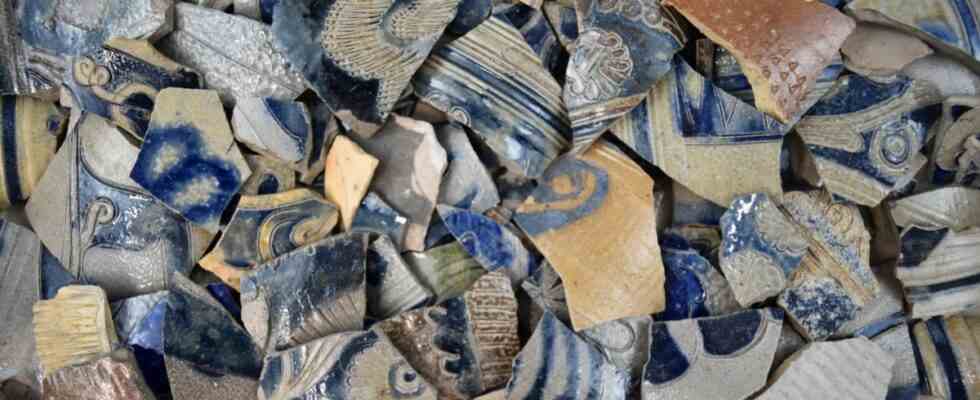The fact that the village of Peterskirchen in the Rottal was once known as Vogelnirscherldorf has largely been forgotten. The strange name came from the fact that many pottery products were made there, including so-called Vogelnirscherl (feeding bowls for birds).
There are plenty of people in Rottal who are interested in archeology and history, which in turn means that almost every excavation pit is inspected with keen eyes. This is what happened during an excavation in the center of Peterskirchen. Members of the support group for the Lower Bavarian Archeology Museum immediately got in motion and secured ceramic relics and the remains of an old stoneware pottery kiln during voluntary excavations.
Stoneware is a type of ceramic that is best known for the stone beer mugs at folk festivals. “The history of these vessels in Bavaria goes back to the 18th century,” says archaeologist and museum educator Anja Hobmaier, who is currently curating an exhibition at the museum in Landau an der Isar about the beginning and rise of stoneware pottery in Bavaria.
What is certain is that stoneware was used in Bavaria long before the production in Peterskirchen. For example, bottles with healing water from mineral springs as well as high-priced drinking and dispensing vessels that were offered for sale at markets.
Archival records show an interesting development. According to this, around the middle of the 18th century, potter families from the Westerwald immigrated to Peterskirchen, from an area that was also called the Kannenbäckerland. These were highly specialized craftsmen. “The large distance between the region of origin and Lower Bavaria was certainly not carried out without mediation on site,” says Hobmaier. The then Count Maximilian Franz von Tattenbach, who owned Peterskirchen, also had business in the Rhine area. Hobmaier suspects that he might have brought a sample of the Peterskirchen clay to the stoneware potters there for testing. The intention behind this was probably to recruit a new branch of industry for his lands.
“It worked out,” says Hobmaier. For a good 50 years, the Peterskirchen stoneware potters held the monopoly for production in Bavaria south of the Danube. The Westerwald families quickly integrated into Peterskirchen through marriages and godparenthoods, and in a very short time amassed large fortunes. Two notarial deeds testify that one of the potters lent sums equal to the value of several townhouses.
The wealth came to an abrupt end when the customs borders fell in the 19th century, which had made the import of stoneware extremely expensive, which is why the Peterskirchen potters were able to work unrivaled. Railways now transported large quantities of cheap stoneware from other regions and thus cut off the economic survival of family businesses in Peterskirchen.
The excavation showed that stoneware painted blue was already being produced in Peterskirchen around the middle of the 18th century. So far, mostly objects from the late period were known, which are usually brown.
(Photo: Kastenhof Landau)
The gray stone beer mugs are still used today in Bavarian festival tents. According to general opinion, the beer tastes twice as good from it, and there is a good reason for that. Not only does stoneware use a special clay, it is also fired at very high temperatures. The heat causes the clay particles to fuse, making them dense and water-repellent. Above all, the gray goods with blue painting and the dark reddish-brown goods, as produced in Peterskirchen, are well-known.
View of the stoneware exhibition in the Museum Kastenhof Landau.
(Photo: Kastenhof Landau)
The exhibition makes it clear that cylindrical beer mugs have long been produced in Germany and imported to Bavaria. The stoneware potters in Peterskirchen also produced these pieces south of the Danube for the first time. “Peterskirchen can therefore be considered the cradle of the stone beer mugs produced in Old Bavaria,” says Ms. Hobmaier.
Earthen beer mugs, fired at lower temperatures, have been around for much longer. However, these have some disadvantages compared to stoneware, such as increased water permeability, poorer cooling properties and faster wear. Therefore, the stoneware beer mug was able to assert itself at the folk festivals.
Some experts locate the origin of the beer mug in Keferloh near Munich, after all the term “Keferloher” has always stood for a stoneware beer mug without a lid. Siegfried Rübensaal, who probably owns the largest collection of stoneware beer mugs in the world, actually found potsherds in Keferloh that support this thesis. However, they point out that the jugs made from this material were porous and the glaze contained lead. The early Keferloher was therefore not a stoneware jug.
As for the lid on the beer mug, according to the Rübensaal, it was a status symbol. The lid was individually designed by the tin caster. A problem arose with the beer tents: the lid was considerably more expensive than the mug. And it lasted much longer. If a jug broke, the lid had to be reinstalled. The councilor of commerce Georg Pschorr then introduced the lidless jug around 1880 under the traditional name Keferloher with great success.
“Stoneware! Of pot bakers and old Bavarian beer mugs”. Kastenhof Landau. Stone Age and Contemporary Museum, until March 5th. Wednesday to Sunday 10am-1pm and 2pm-5pm.

